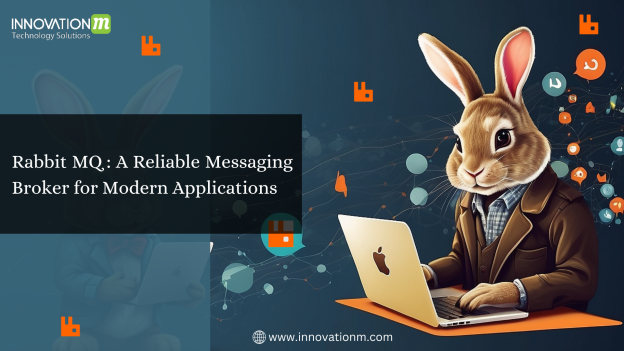Introduction
In the fast-paced world of modern software development, applications often need to communicate with each other efficiently and reliably. RabbitMQ, an open-source message broker, has emerged as a popular choice for managing messaging queues between different components in distributed systems. In this blog, we will explore the key features and benefits of RabbitMQ and why it has become an essential tool for building scalable and robust applications.
What is RabbitMQ?
RabbitMQ is a message broker that implements the Advanced Message Queuing Protocol (AMQP). It acts as an intermediary, receiving and routing messages between applications and services. The core concept behind RabbitMQ is the decoupling of components in a system, enabling asynchronous communication and reducing the risk of bottlenecks.
How Does RabbitMQ Work?
At its core, RabbitMQ operates on a simple principle: producers send messages to exchanges, which then route those messages to queues. Consumers then retrieve and process the messages from these queues. This architecture ensures that the components in a system can function independently, leading to better scalability and fault tolerance.
Key Features of RabbitMQ
a. Message Durability: RabbitMQ allows messages to be persisted on disk, ensuring that they are not lost in the event of a system failure. This feature is crucial for applications that prioritize data integrity.
b. Message Acknowledgment: RabbitMQ supports acknowledgment mechanisms, which means that once a consumer successfully processes a message, it acknowledges its receipt. If the acknowledgment is not received, RabbitMQ will attempt to redeliver the message.
c. Exchange Types: RabbitMQ offers different types of exchanges, such as direct, topic, fanout, and headers exchanges, allowing developers to tailor message routing based on their specific requirements.
d. Dead-Letter Exchanges (DLX): DLX enables the re-routing of undeliverable or expired messages to a designated queue, providing a way to handle exceptional scenarios gracefully.
e. Shovel Plugin: RabbitMQ’s shovel plugin allows easy replication of messages between different RabbitMQ instances, enabling distributed systems and disaster recovery scenarios.
Use Cases for RabbitMQ
a. Microservices Architectures: RabbitMQ plays a pivotal role in microservices-based applications, where independent services need to communicate with each other efficiently without creating tight dependencies.
b. Task Queues: By using RabbitMQ to distribute tasks among workers, developers can implement efficient background processing, making it ideal for computationally intensive tasks or time-consuming operations.
c. Real-time Communication: RabbitMQ facilitates real-time communication between web applications, allowing for instant updates and seamless user experiences.
RabbitMQ vs. Other Message Brokers
While there are other message brokers available, RabbitMQ stands out due to its active community, robustness, and support for multiple protocols, including AMQP, MQTT, and STOMP. Its flexible architecture and extensive plugin ecosystem make it a preferred choice for a wide range of applications.
Getting Started with RabbitMQ
Setting up RabbitMQ is relatively straightforward. It can be installed on various operating systems, and its management console makes it easy to monitor and manage queues, exchanges, and bindings.
Let’s implement a Task Queue using RabbitMQ with Spring Boot in Java. We’ll use the spring-amqp library to interact with RabbitMQ. Ensure you have set up RabbitMQ and have Spring Boot set up with Maven or Gradle.
Step 1: Set up Spring Boot Project
First, create a new Spring Boot project with the necessary dependencies:
<!-- pom.xml --> <dependency> <groupId>org.springframework.boot</groupId> <artifactId>spring-boot-starter-amqp</artifactId> </dependency>
Step 2: Configure RabbitMQ Connection
Add the RabbitMQ configuration in application.properties:
# application.properties spring.rabbitmq.host=localhost spring.rabbitmq.port=5672 spring.rabbitmq.username=guest spring.rabbitmq.password=guest
Step 3: Create Task Producer
Now, let’s create a component that acts as a Task Producer to generate and send tasks to the RabbitMQ queue:
import org.springframework.amqp.core.Queue;
import org.springframework.amqp.rabbit.core.RabbitTemplate;
import org.springframework.beans.factory.annotation.Autowired;
import org.springframework.stereotype.Component;
@Component
public class TaskProducer {
private final RabbitTemplate rabbitTemplate;
private final Queue taskQueue;
@Autowired
public TaskProducer(RabbitTemplate rabbitTemplate, Queue taskQueue) {
this.rabbitTemplate = rabbitTemplate;
this.taskQueue = taskQueue;
}
public void sendTask(String task) {
rabbitTemplate.convertAndSend(taskQueue.getName(), task);
System.out.println("[x] Sent '" + task + "'");
}
}
Step 4: Create the Main Spring Boot Application
import org.springframework.boot.SpringApplication;
import org.springframework.boot.autoconfigure.SpringBootApplication;
@SpringBootApplication
public class RabbitMqTaskQueueApplication {
public static void main(String[] args) {
SpringApplication.run(RabbitMqTaskQueueApplication.class, args);
}
}
Now, when you run the Spring Boot application, the producer will send tasks to the RabbitMQ queue, and the consumer(s) will process them asynchronously.
Make sure RabbitMQ is running, and then you can test the application:
import org.springframework.beans.factory.annotation.Autowired;
import org.springframework.boot.CommandLineRunner;
import org.springframework.stereotype.Component;
@Component
public class AppRunner implements CommandLineRunner {
private final TaskProducer taskProducer;
@Autowired
public AppRunner(TaskProducer taskProducer) {
this.taskProducer = taskProducer;
}
@Override
public void run(String... args) {
// Simulate sending tasks
for (int i = 1; i <= 5; i++) {
taskProducer.sendTask("Task " + i);
}
}
}
Now, when you run the Spring Boot application, you’ll see the tasks being sent by the producer and processed by the consumer(s) asynchronously. RabbitMQ effectively acts as a reliable messaging broker, ensuring that tasks are distributed and processed efficiently across multiple consumers.
Conclusion
In conclusion, RabbitMQ has become a vital component in modern application development, providing reliable messaging services that enable seamless communication between distributed systems. Its ability to decouple components, ensure message durability, and support various exchange types make it an excellent choice for building scalable and fault-tolerant applications. Whether you are working on microservices, real-time communication, or background processing, RabbitMQ’s versatility and robustness make it a powerful messaging broker worth considering for your next project.
 End to End Technology Solutions
End to End Technology Solutions
